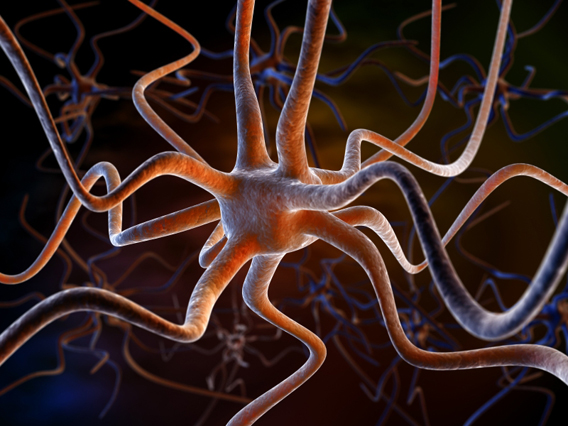Building Block Identified for Brain Connections
Researchers find key role for a specialized protein in assembly of neuronal synapses associated with Alzheimer's
One of the building blocks of a key neural synapse implicated in Alzheimer's disease, age-related hearing loss and certain forms of epilepsy and schizophrenia has been identified by Tufts researchers.

A 3D macro rendering of neuron brain cells. Illustration: Henrik Jonsson/iStock
Rapid information processing in the nervous system requires synapses, the specialized contact sites between nerve cells and their targets. In a study, the Tufts researchers and their colleagues focused on cholinergic synapses, which are essential for normal learning and memory, arousal, attention and all autonomic, or involuntary, nervous system functions.
"We have identified the protein adenomatous polyposis coli (APC) as a key organizer of a multi-protein complex that is required for assembly of neuronal cholinergic synapses," says Michele H. Jacob, a professor of neuroscience at the School of Medicine.
By identifying the role of APC and its associated proteins in organizing synapses, the findings bring scientists "closer to understanding disorders of cognition and neurological function on a molecular level," she says.
APC is expressed in all cell types and has multiple functions and binding partners. It is best known for its role in colorectal cancer. "Our work defines a novel role for APC in neurons," says Jacob.
APC gene mutations have also been associated with mental retardation, schizophrenia and autism spectrum disorders, characterized by severe impairment in thinking, feeling, language and the ability to relate to others.
Their findings "support the emerging concept that APC is a central organizer of a core multi-protein complex that directs the assembly of excitatory, but not inhibitory, synapses in the vertebrate nervous system," Jacob notes.
Jacob, Madelaine Rosenberg, a research associate in neuroscience, and their colleagues report their findings in the June issue of Molecular and Cellular Neuroscience. The study was funded by the National Institute of Neurological Disorders and Stroke and the National Institute of Diabetes and Digestive and Kidney Diseases.


